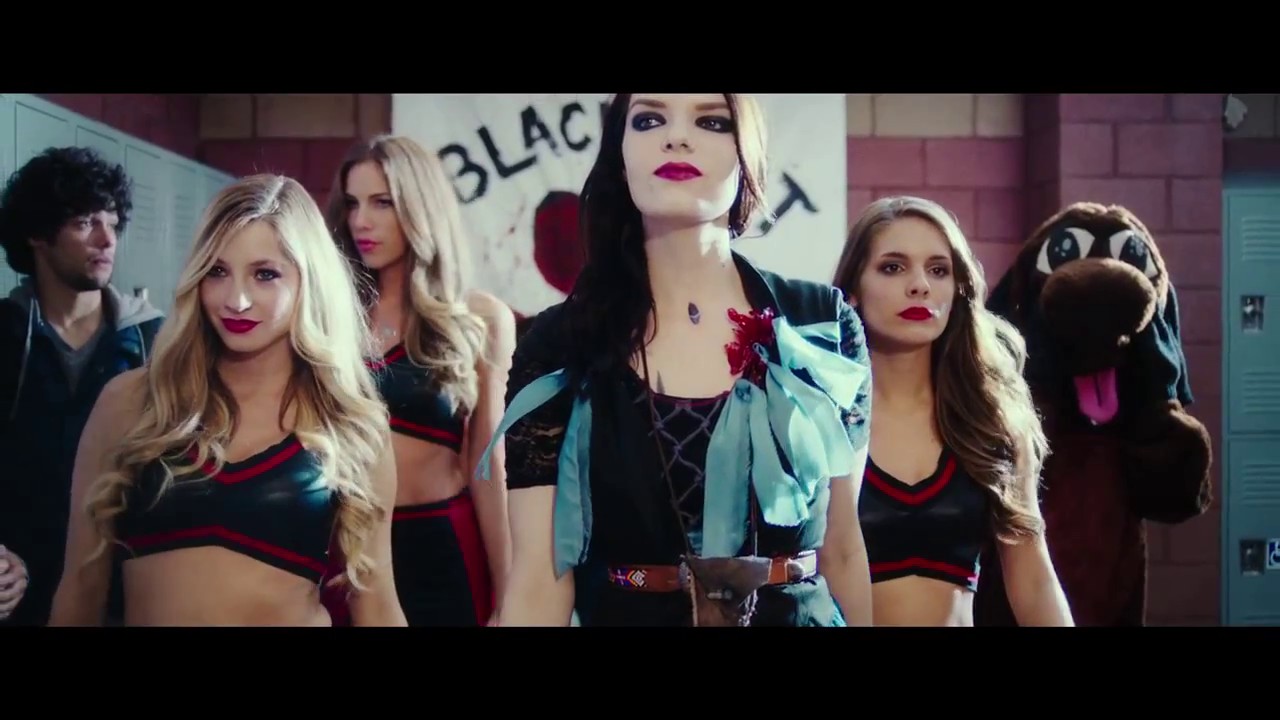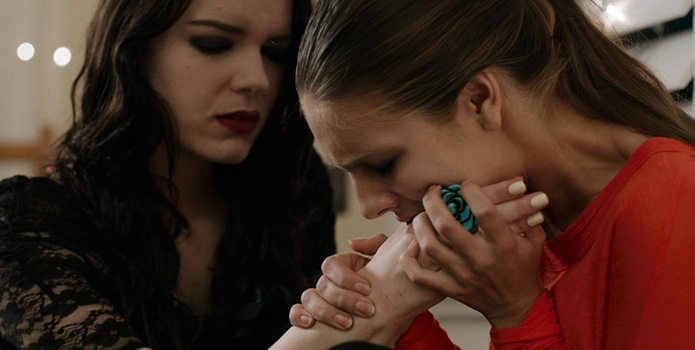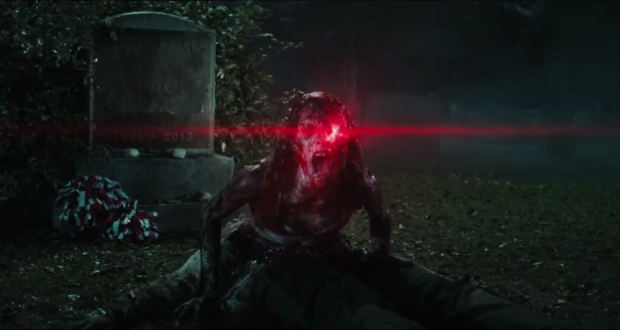Lucky McKee and Chris Sivertson have been here before. In 2001, the pair collaborated on ALL CHEERLEADERS DIE, a SOV film made when the duo were right out of college. The pair have had divergent career paths, McKee helming genre faves likes MAY, RED and THE WOMAN and Sivertson directing the notable I KNOW WHO KILLED ME and the Jack Ketchum adaptation THE LOST. But the two have recent reunited to return to their original film, creating a new ALL CHEERLEADERS DIE for a modern age, utilizing all of the knowledge (and budget) to which they now have access.
We reviewed the film, now available on VOD and making its way to theaters soon, earlier this week, but had a chance to talk to the pair about their latest collaboration and how it’s very different from their other work.

DAILY GRINDHOUSE (DG): What made you decide to revisit ALL CHEERLEADERS DIE?
CHRIS SIVERTSON (CS): Well, it’s where we started. We made it right out of film school, we just wanted to make our own movie and that was our initial impulse was to do cheerleaders versus football players, madness ensues. And in that case it was cheerleaders come back as rotting zombies to get their revenge on the football players who have wronged them. We just had a blast making it, we learned so much, and then went off and did our solo careers. And then it got to the point where we were both ready to shake things up and try something new, and go back to that original impulse we had and seeing what we could do with it with everything we had learned making our own movies. The spirit it was done in was a lot of fun.
LUCKY MCKEE (LM): Plus we’re trying to recapture our youth.
CS: Yeah. There’s always that.
DG: What made you want to do something that’s not as dark as your other work?
LM: That’s exactly the reason right there – you make these dark, brooding character studies for too long and it starts to have an effect on you in a negative way. It’s good to get that dark stuff out, but there’s more to life than that.

DG: You do still see some of that darkness in ALL CHEERLEADERS, because there is more of an emphasis on character development, and it does deal with actual issues that young women have to deal with, and that’s certainly different from the original — was there an intention to put more character-based, more of a drama aspect to the film?
CS: Yeah, definitely, because we both learned a lot as writers and filmmakers making the original. And we both love working with actors and we wanted to create some fun parts, to find the right people for them and let these characters come to life. And there is definitely some dark stuff in the movie that hopefully comes out and takes people by surprise because it’s juxtaposed with some wacky, funny stuff. We wanted to juggle those tones and keep the audience on its toes. And also, getting back to what we’d said before, thinking back to teenage years, one day could be full of so many different emotions, and we kind of wanted to be true to that.
LM: Yeah. Between those dark elements that we’ve explored exhaustively in our previous films, and giving ourselves the challenge of switching that tone up and seeing that contrast between the dark and the light was really fun.
DG: Was it difficult keeping all of these divergent tones together to be this coherent piece? I’ve read a couple takes on the film where people weren’t really prepared for these different tones, they were expecting it to be more on one path.
CS: Yeah, we wanted to mess with people’s expectations for sure. Especially in the editing phase, there was a lot of playing around with balancing that kind of stuff. But some of it is just kind of natural, with so many different kinds of things, we tried to make a movie that never settles into one thing for too long before shifting, and I guess, yeah, there’s plenty of pitfalls there, but we just found places to switch the tones that felt right for us.

DG: Were either of you involved with football or cheerleader culture at all? The depiction of it in the film makes it seem very insular.
LM: I did, a little bit. I played basketball – I was terrible, but yeah, I knew a mixture of people. I was kind of the person who was friends with all of those different cliques. I saw a lot of that jock culture, and definitely had my eyes on cheerleaders and stuff like that. How could you not, you know? But I definitely had some experiences like that in high school.
CS: Yeah, me too. And I think that it was intentional to show it as an insular culture, and I think that any kind of group or clique or team has that insular thing, where they’ll band together in different tribes. In high school, football team and cheerleading squad are two traditionally all-American examples of that.
LM: And high school culture in general being insular from adults. There’s only really one adult in the film, Larry, and that was an intentional choice to take the Peanuts route and keep it about the kids as much as possible, and their social structure, what’s going on in their world and what their concerns are. Keeping the adults out of it.
CS: Yeah, when you’re a teenager, you kind of have two different identities, one with your friends, and then you’ve got a home identity with your family, and they’re kind of two different worlds, and our intention was just to make this about the school world and the friend world. And anything else was a distraction, and during the story writing phase, anything outside of that we just threw away.

DG: When it comes to the writing, the female characters are almost entirely the focus of the film – the male characters are essentially archetypes to get things moving. There’s a quote from Joss Whedon when someone asked him why he wrote such strong female characters, and he responded “Because you’re still asking me that question.” Does the idea that writing strong female characters is still considered an anomaly contribute to your wanting to write them?
LM: Well, horror films aren’t just for boys too! There are a lot fewer characters that women can identify with in film in general, so to us, that’s kind of more interesting, a little bit more uncharted territory – obviously, there’s a lot of great female filmmakers and actors out there always showing us new things, but for us, it’s just interesting.
DG: How does the co-directing work? You co-directed the original, did you fall into the same habits on this version?
LM: We hold hands a lot. We go to the bathroom together… [laughs] I don’t know, you’ve got two guys that have been friends for over half their lives just getting together, the collaborative aspect is a lot easier. It’s not like Chris and I just met each other and decided to make a movie together, we’ve known each other since we were the age of the characters in this film. So there’s just kind of a natural second hand that goes on between us. I think we’re both aware of our strengths and our weaknesses, and we challenge ourselves on our weaknesses and play to our strengths.

DG: How did you find your lead actresses? Caitlin [Stasey] and Sianoa [Smit-McPhee] are Australian, how did they end up on the project?
CS: They both just came in and read, and both of them just blew us away. They both had that thing where they come in and all of a sudden your character is alive and better than you even thought it could be because it’s real, and your character is making choices that you didn’t expect, and it’s exciting – it’s exactly what you look for in the casting process rather than what you see in your head. It should really be surprising and exciting, and that’s when things really come to life, and as we started to get them in the movie, we suddenly realized that Caitlin and Sianoa had known each other since they were kids, as they were both on the Australian show “Neighbors” together, so they already had this history between them, which was a really fun coincidence that worked out great for us. There’s another Australian actor in the movie as well and two New Zealand actors, so it’s like half our young cast turned out to be from either Australia or New Zealand totally by coincidence. A lot of them fooled us and used American accents in the audition, and then they started talking in these accents – it was just a fun thing that happened, and for whatever reason, the actors from down there are fucking serious about what they do. Everybody what was cast in this movie got cast because they came in and owned the role, and gave us know choice but to cast them.
LM: Yeah, Sianoa specifically was the only actress that we saw that made us truly believe that something magical was going on, which was one of the more outlandish aspects of the story, but if the character doesn’t believe what’s going on in the story, the audience won’t. Sianoa made us believe in the magic even more than we did when we wrote the script, she brought so much to it.
CS: Yeah, being this teenage girl that just realizes she has magical powers at her fingertips which, when you think about it, could come across as ridiculous and trite, but when you have someone like Sianoa come in, who actually thinks about how that would feel for a teenage girl and then delivers that, it was better than we could have hoped for.
DG: Thanks! I’ll leave you with a quick an easy one — What have you seen lately that you really liked?
LM: I would saw BIG BAD WOLVES is one of my favorite recent films. Recently, I got to watch Bergman’s WILD STRAWBERRIES for the first time, and it kind of blew my mind.
CS: And I really liked THE SACRAMENT, which we saw in Toronto and is on VOD now. I also really liked DRINKING BUDDIES. Those are two recent ones that got me excited.
Thanks to Lucky and Chris for taking the time for the interview!
@Paul Freitag-Fey
- [THE BIG QUESTION] WHAT’S YOUR FAVORITE FEMALE ENSEMBLE IN MOVIES? - July 22, 2016
- [IN THEATERS NOW] THE BOY (2016) - January 24, 2016
- Cult Movie Mania Releases Lucio Fulci Limited Edition VHS Sets - January 5, 2016






No Comments